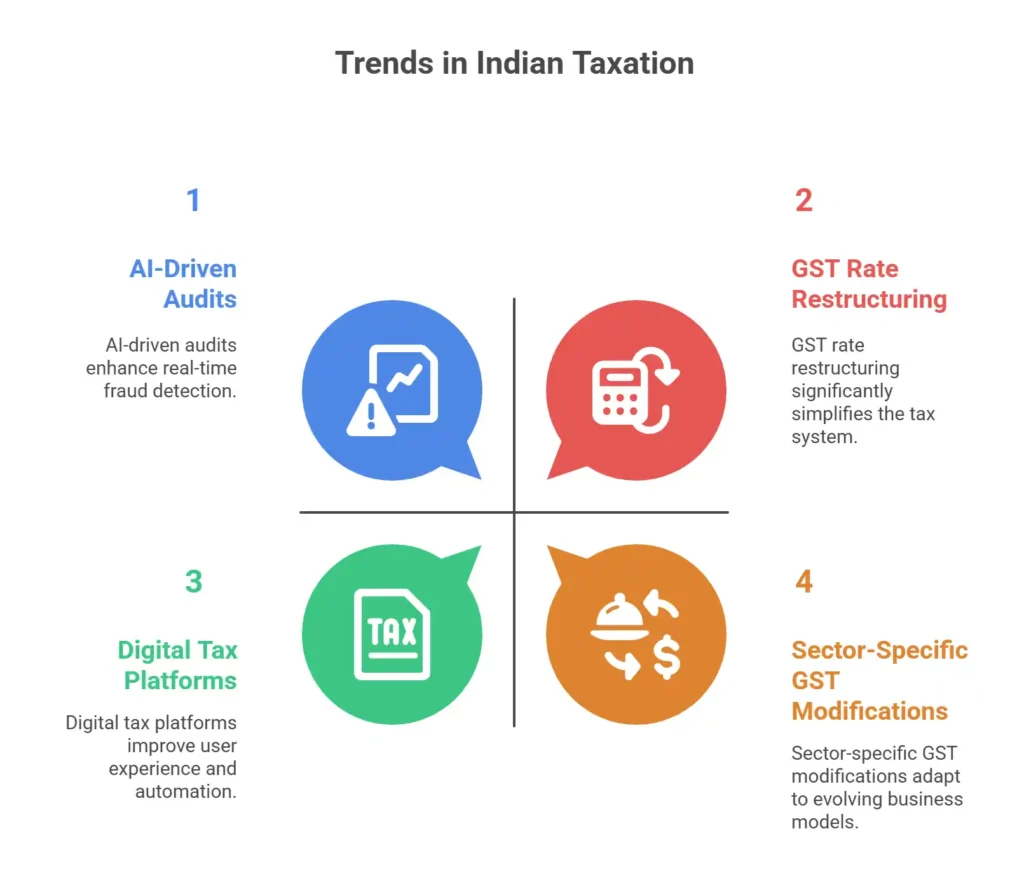Taxation is a critical component of economic policy, influencing businesses, investments, and economic growth. The future of Indian taxation is expected to undergo significant changes in 2025, driven by new technology, rule changes, and global influences. Understanding these shifts is essential for businesses to stay compliant and competitive. This blog explores key trends shaping Indian taxation, anticipated reforms, and strategies businesses can adopt to prepare for the evolving tax landscape.
Key Trends Shaping Indian Taxation in 2025

1. Digitalization of Tax Systems
The Indian taxation system is slowly adopting technology to improve efficiency and compliance. One of the most notable advancements is the expansion of e-invoicing. Businesses are required to generate invoices electronically, reducing tax evasion and ensuring transparency. Additionally, automated tax filings and artificial intelligence-driven audits are expected to become mainstream.
- Expansion of Digital Tax Platforms: The Indian government is also enhancing its digital platforms to ensure seamless tax filing. Platforms such as GSTN and the Income Tax portal are expected to undergo upgrades for a better user experience and automated processing.
- AI and Big Data Integration: The use of AI and big data in tax compliance will allow authorities to detect irregularities and prevent fraud in real-time, making tax collection more efficient.
- Enhanced Taxpayer Support Systems: The introduction of AI-driven chatbots and automated grievance redressal systems will streamline interactions between taxpayers and authorities.
- Automated Notice System & Fraud Detection: The Income Tax Department now sends notices to taxpayers through an online system, capturing data from various sources to track fraudulent activity. Unlike 5-10 years ago, when authorities lacked sufficient data, this system enhances transparency and ensures compliance.
2. Expected Changes in GST Rates and Structure
The future of Indian taxation will likely see changes in the Goods and Services Tax (GST) regime. Policymakers are considering restructuring GST slabs to simplify the tax system. There is a growing demand for merging the 12% and 18% slabs into a single rate to reduce classification disputes. Additionally, more exemptions may be removed to broaden the tax base and enhance revenue collection.
- GST Compliance Enhancements: Businesses may witness improved refund processing systems and real-time compliance tracking to reduce delays and fraud.
- Sector-Specific GST Modifications: Certain industries, such as e-commerce and digital services, may see revised GST classifications to account for their evolving business models.
Anticipated Tax Reforms in India
1. Reforms in Direct and Indirect Taxes
The Indian government has been actively working on tax simplification measures. Corporate tax rates have already been reduced, and further rationalization is expected in 2025. The focus will be on reducing tax litigation, streamlining income tax return processes, and incentivizing compliance. In indirect taxation, GST reforms will continue to enhance the ease of doing business.
- Taxpayer Charter Expansion: New taxpayer rights and obligations may be introduced to ensure fair treatment and reduce bureaucratic hurdles.
- Enhanced Tax Deduction Options: The government may introduce new deductions to encourage investments in green energy and technology-driven businesses.
2. Simplification of Compliance Processes
Taxpayers often struggle with complex rules to follow. The introduction of faceless assessments and e-adjudication aims to reduce human intervention and make tax filings more efficient. In 2025, more businesses will be able to leverage automated systems to manage their tax liabilities seamlessly.
- Role of Artificial Intelligence in Tax Compliance: AI-based chatbots and predictive analytics will likely be integrated into government tax portals to assist taxpayers in filing returns efficiently.
- Digital Identity Verification: Aadhaar-based and biometric authentication could be used for faster taxpayer verification, reducing fraud risks.
Impact of Global Tax Trends on Indian Taxation
1. Influence of OECD Rules
India is adjusting its tax rules with global standards set by the Organisation for Economic Co-operation and Development (OECD). The use of new OECD rules for digital taxation will impact multinational corporations operating in India. These rules focus on ensuring fair tax distribution and preventing base erosion and profit shifting (BEPS).
- Impact on Foreign Companies: Many global tech giants operating in India will need to comply with India’s digital taxation framework, potentially increasing their tax liabilities.
- Cross-Border Taxation Compliance: Indian businesses expanding internationally will have to align with global tax frameworks, impacting their operational strategies.
2. International Trade and Tax Policies
The future of Indian taxation will also be shaped by trade agreements and evolving global tax treaties. With the increasing focus on digital services, India may introduce new regulations to tax foreign digital entities operating within the country. This will ensure that foreign companies contribute fairly to India’s tax revenue.
- New Bilateral Tax Treaties: India may renegotiate tax treaties with major trade partners to create a fairer system of tax sharing.
- Digital Services Tax Expansion: More stringent tax policies may be introduced to capture revenues from global digital platforms operating in India.
What Businesses Should Do to Prepare
1. Adaptation Strategies for Startups and SMEs
Small and medium-sized enterprises (SMEs) and startups must prepare for the upcoming tax changes by adopting efficient tax planning strategies. Understanding GST compliance, digital tax filing, and leveraging government incentives will be crucial for maintaining profitability.
- Training and Skill Development: Businesses should train their finance teams to understand upcoming changes and ensure full compliance.
- Proactive Compliance Audits: Companies should conduct internal audits regularly to ensure adherence to evolving tax policies and avoid penalties.
2. Leveraging Technology for Compliance
Businesses should invest in tax automation tools and enterprise resource planning (ERP) systems to streamline compliance. The use of AI tools can help businesses identify potential tax savings and avoid penalties due to non-compliance.
- Blockchain in Tax Compliance: Blockchain technology may emerge as a key tool for tracking transactions and ensuring transparency in tax reporting.
- Automated Tax Planning Tools: AI-driven platforms may assist businesses in optimizing their tax liabilities and improving efficiency.
Conclusion
The future of Indian taxation is set to be dynamic, with technological innovations and policy changes playing a crucial role. Businesses must proactively adapt to these changes by using digital tools, staying informed about policy updates, and implementing strategic tax planning. By preparing in advance, companies can navigate the evolving tax landscape efficiently and ensure compliance in 2025 and beyond.
FAQs
GST is expected to undergo structural reforms, including rate rationalization and improved compliance measures. The government may merge certain tax slabs to simplify the system.
India is focusing on direct and indirect tax simplifications, including faceless tax assessments, reduction in corporate tax rates, and streamlined GST processes.
International tax regulations, such as the OECD’s digital taxation framework, will influence how multinational corporations operate in India. Foreign digital service providers may face new taxation rules.
Businesses should invest in digital compliance tools, stay updated on regulatory changes, and implement proactive tax planning strategies to adapt to new tax laws.
Automation, AI-driven analytics, and ERP software can help businesses manage tax compliance efficiently, reducing manual errors and ensuring timely filings.










